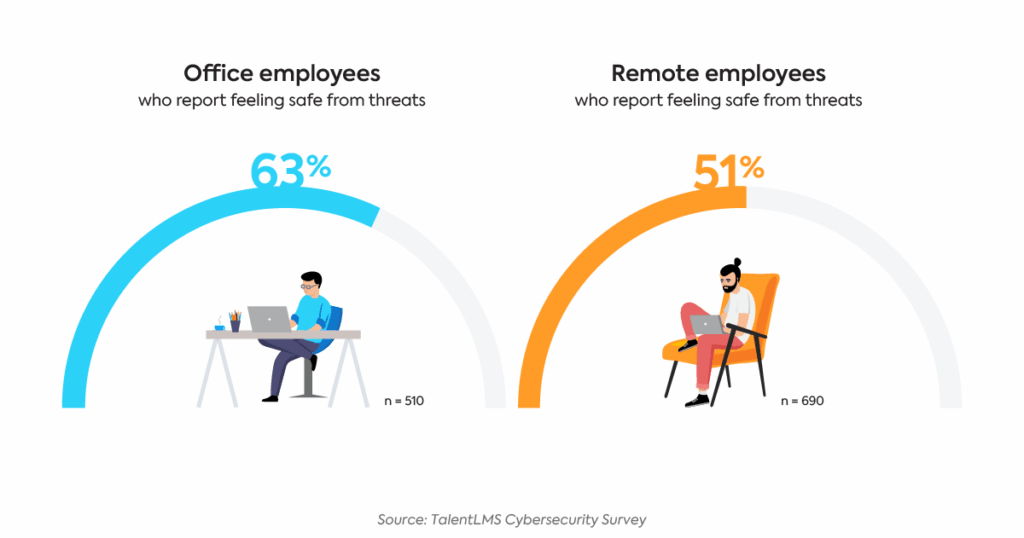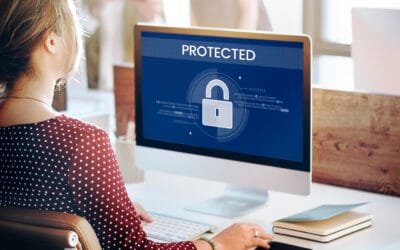Remote work’s rise has made cybersecurity essential. Workers accessing systems outside office networks face risks like phishing and data breaches. Best practices, such as securing Wi-Fi and using strong passwords, are vital to protect sensitive data and organizational integrity in today’s digital world.
As per the IBM Security’s 2024 study, it has been found that 60% of data breaches involved remote workers, underscoring the need for strong cybersecurity.
Top Best Practices of Cybersecurity for Remote Workers
1. Conduct Awareness Training
It never hurts to give everyone a refresher on security tips for working remotely, and to teach them some new things about cybersecurity. Cybercriminals are always evolving along with the technology. What was taught a year or two ago may not be relevant or could need updating with new information. Plus, with so many people working from home now, cybercriminals may adjust their tactics in an attempt to thwart IT security risk management efforts.
Be sure that all employees understand the risks of phishing emails, ransomware, social engineering and other possible means criminals can use to force their way into company data. Phishing has become a preferred tactic for many cybercriminals, with attacks increasing by 58.2% globally in 2023 alone. To underscore the sophistication, nearly 3.4 billion phishing emails are sent worldwide every day. On-site and remote workers could easily fall victim if they lack awareness about the threat.
2. Implement Strong Passwords and Two-Factor Authentication
Long passwords with a combination of letters, numbers and special characters intended to foil deciphering should be mandatory for all employees. It’s recommended to change passwords when there is reason to suspect a compromise, and routinely on an annual basis for more airtight security.
For a stronger authorization process, implement two-factor authentication for all users. This often entails an authorized user putting in a code they’ve been sent on their personal mobile device, which no unauthorized person should have access to.
3. Use Virtual Desktop Infrastructure
Virtual Desktop Infrastructure (VDI) is a great cybersecurity tool that lets authorized users securely connect to an organization’s networks and access their assets remotely through any internet connection from almost any device and location. The secure aspect of VDI protects company information from the get-go, mitigating cybersecurity risk and ensuring no unauthorized access is obtained. Implementing and enforcing VDI security best practices adds another layer of remote work security.
Similarly, keeping cyber crooks from trying to sneak by impersonating employees also keeps them from accessing information or networks. User identity verification for help desks is instrumental in determining valid users, a particularly important metric with remote employees.

4. Work on Private Networks
Even on a company-owned device loaded with antivirus software and other protections, it’s never a good idea to log onto a wide-open public network. You don’t want remote workers headed to the corner cafe for a cup of coffee and a quick work session on that coffee shop’s network, not-so-cleverly called “Coffee Shop WiFi,” with its equally unclever password, “Guest.” These kinds of unsecure or minimally secure networks are easy for criminals to enter.
Remote and hybrid employees should work on a home network protected by a strong, tough-to-break password that won’t easily let in cybercriminals.
5. Use the Cloud
The development of services like Microsoft Office 365 and Google Workspace has allowed businesses to conduct their work fully online while taking advantage of the excellent security measures put in place by these industry titans.
The cloud is also quite convenient. With everything located online, materials can be accessed from any device with the correct authorization and credentials.
6. Keep Software & Hardware Updated
Bugs and vulnerabilities are routinely found in just about every operating system or antivirus software, so frequent updating is key. Roll out updates remotely to all company-owned devices as often as necessary.
7. Be Mindful of Private Info on Video Calls
Zoom, Teams, Skype and any other video conferencing software are ubiquitous in everyday business operations. It’s critical that employees make sure no sensitive personal or company information inadvertently appears on camera with them. Likewise, screen-sharing must be done with care. A best practice is to review and prepare desktops before meetings to confirm they don’t contain sensitive information that isn’t meant to be widely shared.
8. Only Use Work Devices for Work
Among the most important remote work security tips is encouraging employees to keep work exclusively on company-issued devices and everything else on their own devices. Personal web browsing could lead to insecure connections on some sites or fake merchant pages that are all vulnerable to attacks or malware, putting the company’s assets at risk.
Conclusion
Cybersecurity for remote workers is a shared responsibility that demands proactive measures and awareness. By adopting best practices like securing devices, using VPNs, and staying alert to cyber threats, remote employees can safeguard sensitive data and contribute to their organization’s overall security. In an era where remote work is the norm, prioritizing cybersecurity ensures both personal and professional resilience against an ever-evolving threat landscape.
Ready to secure your remote workforce? Contact The Expert Community for a free cybersecurity services!
FAQ
1. Why is cybersecurity important for remote workers?
Remote workers access systems outside secure office networks, making them vulnerable to cyber threats like phishing and data breaches.
2. What are the top cybersecurity risks for remote employees?
Common risks include unsecured Wi-Fi, phishing attacks, weak passwords, malware, and lack of device encryption.
3. How can remote workers secure their home Wi-Fi?
Use a strong, unique password, enable WPA3 encryption, and disable remote management to secure home Wi-Fi networks.
4. Should remote workers use a VPN?
Yes, a VPN encrypts internet connections, protecting data from interception, especially on public or unsecured networks.
5. How can remote workers avoid phishing attacks?
Avoid clicking on suspicious links, verify email senders, and use multi-factor authentication to reduce phishing risks.







